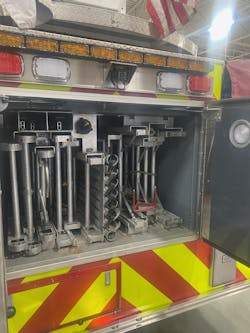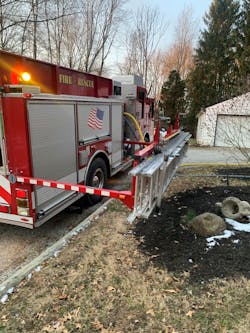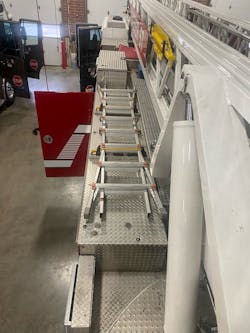Specifying portable ladder packages is part of the initial analysis that must be completed by the apparatus committee. Of the numerous metrics that must be considered when making this analysis, apparatus type, availability of staffing, response district(s) and run response cards are perhaps the four most important. Unlike other design aspects of apparatus, portable ladders take up a specified amount of space that can’t be altered because of their rigid construction. Once the apparatus committee determines the size, quantity and type of portable ladders to be carried, mounting and ease of deployment are essential aspects to ensure effective fireground operations.
Apparatus type
Apparatus type plays a significant role in the portable ladder package that will be carried on the apparatus. Most basic engine companies are specified with a single straight ladder, an extension ladder and a folding ladder to meet minimum standards. Single ladders typically are 14–16 feet in length; extension ladders are 24–28 feet in length; folding ladders usually are 8–10 feet in length. A utility, or A-frame, ladder also might be necessary for service and investigation incidents.
When specifying rescue-engines or squad companies, departments often specify longer portable ladders in case they are assigned the role of a traditional ladder company on the fireground. These include 16-foot straight ladders and 28-foot or three-section 35-foot extension ladders. Again, a single folding ladder and utility ladder often are required for service and investigation incidents. Multiple extension ladders frequently are recommended, thus greatly exceeding minimum portable ladder requirements.
Aerial apparatus come in an array of types and styles. Nonetheless, if the aerial apparatus is to fulfill the role of the ladder company on structural fires, a substantial portable ladder package must be included to achieve standard fireground objectives. Again, minimum portable ladder standards are just that: a minimum. This applies for both quint and straight aerial apparatus types. Often when I assist an apparatus committee with this step in its analysis, it quickly becomes apparent that the need is two- to three-fold that of minimum requirements.Aerial apparatus have the advantage of longer body styles compared with their engine company counterparts. With this comes the advantage of greater portable ladder storage. This can be accomplished through the main torque box in the rear or side-stacking on the body. Combinations of both are extremely popular for quint and straight aerial apparatus and easily are designed by most apparatus manufacturers. This also can allow you to carry a two-section ladder, as opposed to a three-section one, which can cut substantial weight and banking widths from the ladder in most cases.
Aerial apparatus generally carry two to as many as four extension ladders from 24 feet to 50 feet. Multiple straight ladders from 16 to 20 feet also are required generally, as are multiple 8- to 14-foot folding ladders and a utility ladder. The current trend of 100-foot, single-axle quint apparatus makes this type of portable ladder package highly unlikely without a drastic reduction of compartmentation. Overwhelmingly, this can result in the portable ladder package suffering and being reduced to minimum requirements.
Staffing
Staffing levels differ greatly across the fire service, and most staffing levels never will get better than they are today. Although most extension ladders can be raised with a two-person crew, members differ in one way or another in physical ability—thus, this is where training comes in to understand individual limitations.
Depending on the portable ladder’s construction, every ladder that’s 35 feet and shorter can be a maximum of a two-person raise. This increases the efficiency and effectiveness of the exterior ladder team. Portable ladders that are 45 feet and longer might consume an entire company of four personnel to raise.
Two-section ladders that are 24 feet and 28 feet in length are the go-to ladders of the fire service. Both can be thrown easily by a single person. The 28-foot ladder gives the added advantage of capturing the third-story window in most garden apartments with a terrace level on the first floor. Straight ladders offer rapid placement to upper floors and roofs with a quick, single-person throw. Commonly, these range from 14 to 20 feet and have slim banking widths, so a member usually can carry several that are stowed together tightly. Thus, a single firefighter who is carrying tools can grab two off of the apparatus at once and quickly cover multiple points on the fire building.Response district
Response district plays a significant role in determining the portable ladder package that’s required for both first-due and extended response districts. Larger municipalities often have different portable ladder packages on identical aerial devices because of the differences in their first-due response area. As the lines in the urban-suburban interface continue to become blurred in many regions of the country, building heights and development densities can increase in what was historically a suburban neighborhood, thus increasing the importance of portable ladders.
Increased demand for longer ladders comes with these changes in building heights and development densities. Multifamily-dwelling fires can consume a portable ladder package on a ladder company quickly. Adding to the need are changes in building construction methods. Most buildings that are considered legacy construction have a standard floor joist, where a 35-foot ladder easily can reach a fourth-story window or a third-story roof. Today’s 18–24-inch manufactured floor joists put most fourth-story windows out of reach of a standard 35-foot ladder depending on the topography that’s around the structure.
Likewise, companies that routinely respond to single-family dwellings benefit from having shorter ladder packages. Multiple 24- or 28-foot ladders are common, and perhaps only a single 35-foot ladder is required for the running area.
When conducting the analysis, ensure that rear yards are taken into account. It’s common for entire streets to have substantial grade changes in the rear yard, which places a finished attic’s window out of reach of a 28-foot ladder.
Run cards
Knowing how many portable ladders respond to a report of fire is just as important for the incident commander as knowing how many aerial devices respond. Portable ladders that are on the apparatus do firefighters no good when they aren’t placed on the fire building.
Once the portable ladder complement that’s on an aerial apparatus is consumed, the portable ladders from the engine companies that are on scene are retrieved until the incident is stabilized. Fireground policy should set specific parameters for placing portable ladders on the fire building.
Occupancy type is another good indication of portable ladder requirements. Many computer-aided dispatch systems are capable of differentiating between occupancy types. There usually is a reduced response for single-family structures compared with their multifamily counterparts. Likewise, commercial building fires likely get even more resources.
It’s easy to adjust run cards accordingly to ensure that enough portable ladders respond, particularly for multifamily structures, which quickly become a sponge for portable ladders and seemingly never have enough portable ladders on scene initially.Ladder mounting
Portable ladder mounting on the apparatus must be identified once the analysis for the size, quantity and type(s) of portable ladders is completed. This has a significant effect on the body style of an engine, a rescue-engine or squad, and an aerial device.
Options for engine and rescue-engine or squad companies range from side-mounted, center or outside arm ladder rack systems, side-mounted dropdown systems, and through-the-body and through-the-hosebed storage.
Options for aerial devices include through the torque box, through the body and side-mounted, and deck-mounted for mid-mount aerials.
Like everything that’s specified on apparatus, there are pros and cons to each mounting option. Some ladder rack types require a significant amount of room for the arms and ladders to deploy, because the ladders are mounted on top of the apparatus. This might become problematic in high-density areas or on rural roads where real estate doesn’t exist.
Any through-the-body or through-the-hosebed mounting has an adverse effect on hose storage and a body’s compartmentation depth.
Heading off ladder design failures
There isn’t one portable ladder package that works for every community. That’s why an apparatus committee must analyze thoroughly the needs of the unit’s response district and the effects that the portable ladders have on apparatus design. Taking time at this step helps to eliminate apparatus design failures that otherwise will be with the organization for quite some time over the operational life of the apparatus.
This article is part of the Apparatus Supplement 2023. The entire supplement can be found here.
About the Author

Mark Miller
Mark Miller is a 26-year veteran of the fire service and currently is a deputy fire chief in Southwest Ohio. He holds a master’s degree in public safety administration, the Executive Fire Officer designation from the National Fire Academy and the Chief Fire Officer designation through the Center for Public Safety Excellence. Miller routinely speaks on fire apparatus positioning on the fireground and conducting an apparatus needs analysis.



